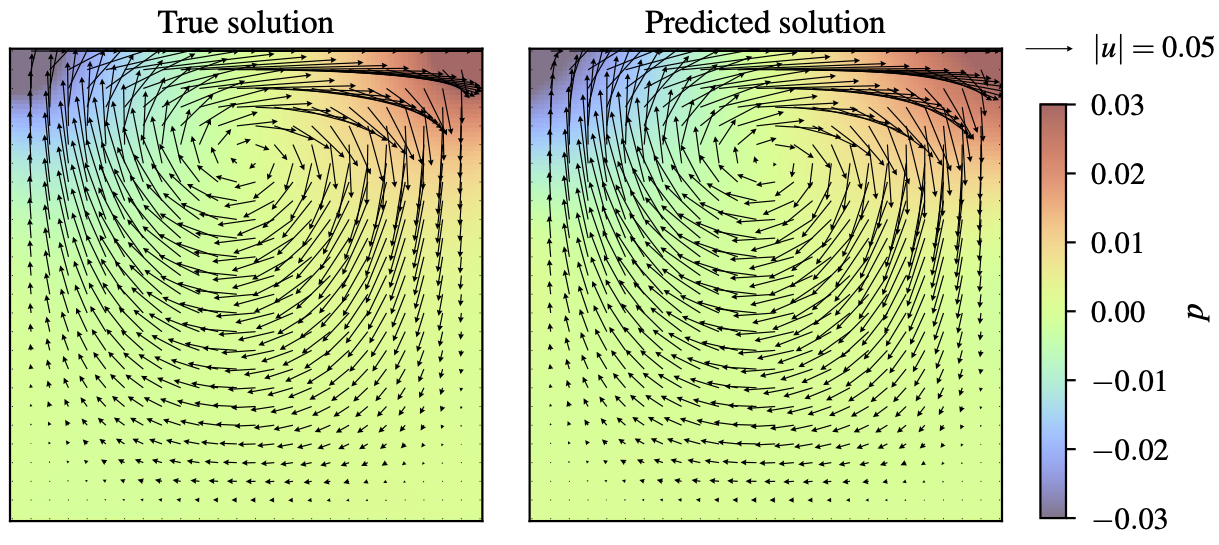PI-DeepONets with Zero Coordinate Shift (ZCS)
Zero Coordinate Shift (ZCS) is a low-level technique for maximizing memory and time efficiency of physics-informed DeepONets (Leng et al., 2023). In this tutorial, we will explain how to activate ZCS in an existing DeepXDE script. Usually, ZCS can reduce GPU memory consumption and wall time for training by an order of magnitude.
Prerequisite
Your current script can be easily equipped with ZCS if you are using
TensorFlow 2.x, PyTorch or Paddle as the backend (use PyTorch for best performance),
dde.data.PDEOperatorCartesianProdas the data class, anddde.nn.DeepONetCartesianProdas the network class.
Usage
Switching to ZCS requires two steps.
Step 1: Replacing the classes in the following table
FROM |
TO |
|---|---|
|
|
|
|
Step 2: Changing the PDE equation(s) to ZCS format
In DeepXDE, the user function for the PDE equation(s) is declared as
def pde(x, u, v):
# ...
To use ZCS, we first create a deepxde.zcs.LazyGrad object, passing
x and u as the arguments. The derivatives of u w.r.t. x
at any higher orders can then be computed by
LazyGrad.compute(orders). For example, the Laplace equation
(\(u_{xx}+u_{yy}=0\)) can be coded as
def pde(x, u, v):
grad_u = dde.zcs.LazyGrad(x, u)
du_xx = grad_u.compute((2, 0))
du_yy = grad_u.compute((0, 2))
return du_xx + du_yy
Note: deepxde.zcs.LazyGrad is smart enough to avoid
re-calculating any lower-order derivatives if a higher-order one has
been calculated based on them. For example, in the above function, if
you add du_x = grad_u.compute((1, 0)) after
du_xx = grad_u.compute((2, 0)), du_x will be returned instantly
from a cache inside grad_u without extra computation.
These are all you need!
Example 1: diffusion reaction
In this example, we activate ZCS in the demo of diffusion reaction equation. The PDE is \(u_{t} - D u_{xx} + k u^2 -v=0\), which is implemented in the original script as
def pde(x, u, v):
D = 0.01
k = 0.01
du_t = dde.grad.jacobian(u, x, j=1)
du_xx = dde.grad.hessian(u, x, j=0)
return du_t - D * du_xx + k * u ** 2 - v
In the ZCS script, we change the PDE to (along with replacing the classes in Step 1)
def pde(x, u, v):
D = 0.01
k = 0.01
grad_u = dde.zcs.LazyGrad(x, u)
du_t = grad_u.compute((0, 1))
du_xx = grad_u.compute((2, 0))
return du_t - D * du_xx + k * u ** 2 - v
The GPU memory and wall time we measured on a Nvidia V100 (with CUDA 12.2) are reported below. For these measurements, we have increased the number of points in the domain from 200 to 4000, as 200 is likely to be insufficient for real applications. Time is measured for 1000 iterations.
BACKEND |
METHOD |
GPU / MB |
TIME / s |
|---|---|---|---|
PyTorch |
Aligned |
5779 |
186 |
Unaligned |
5873 |
117 |
|
ZCS |
655 |
11 |
|
TensorFlow |
Aligned |
9205 |
73 (with jit) |
Unaligned |
11694 |
70 (with jit) |
|
ZCS |
591 |
35 (no jit†) |
|
Paddle |
Aligned |
5805 |
197 |
Unaligned |
6923 |
385 |
|
ZCS |
1353 |
15 |
†ZCS with Jit is on our TODO list.
Example 2: Stokes flow
The Problem
In this example, we use a PI-DeepONet to approach the system of Stokes for fluids. The domain is a 2D square full of liquid, with its lid moving horizontally at a given variable speed. The full equations and boundary conditions are
We attempt to learn an operator mapping from \(u_1(x)\) to \(\{u, v, p\}(x, y)\), with \(u_1(x)\) sampled from a Gaussian process. The true solution for validation is computed using FreeFEM++ following this tutorial.
PDE implementation
Without ZCS, the script with aligned points implements the PDE as
def pde(xy, uvp, aux):
mu = 0.01
# first order
du_x = dde.grad.jacobian(uvp, xy, i=0, j=0)
dv_y = dde.grad.jacobian(uvp, xy, i=1, j=1)
dp_x = dde.grad.jacobian(uvp, xy, i=2, j=0)
dp_y = dde.grad.jacobian(uvp, xy, i=2, j=1)
# second order
du_xx = dde.grad.hessian(uvp, xy, component=0, i=0, j=0)
du_yy = dde.grad.hessian(uvp, xy, component=0, i=1, j=1)
dv_xx = dde.grad.hessian(uvp, xy, component=1, i=0, j=0)
dv_yy = dde.grad.hessian(uvp, xy, component=1, i=1, j=1)
motion_x = mu * (du_xx + du_yy) - dp_x
motion_y = mu * (dv_xx + dv_yy) - dp_y
mass = du_x + dv_y
return motion_x, motion_y, mass
Accordingly, the script with ZCS implements the PDE as
def pde(xy, uvp, aux):
mu = 0.01
u, v, p = uvp[..., 0:1], uvp[..., 1:2], uvp[..., 2:3]
grad_u = dde.zcs.LazyGrad(xy, u)
grad_v = dde.zcs.LazyGrad(xy, v)
grad_p = dde.zcs.LazyGrad(xy, p)
# first order
du_x = grad_u.compute((1, 0))
dv_y = grad_v.compute((0, 1))
dp_x = grad_p.compute((1, 0))
dp_y = grad_p.compute((0, 1))
# second order
du_xx = grad_u.compute((2, 0))
du_yy = grad_u.compute((0, 2))
dv_xx = grad_v.compute((2, 0))
dv_yy = grad_v.compute((0, 2))
motion_x = mu * (du_xx + du_yy) - dp_x
motion_y = mu * (dv_xx + dv_yy) - dp_y
mass = du_x + dv_y
return motion_x, motion_y, mass
Both of them should be self-explanatory.
Results
After 50,000 iterations of training, the relative errors for both velocity and pressure should converge to around 10%. The following figure shows the true and the predicted solutions for \(u_1(x)=x(1-x)\). Note that ZCS does not affect the accuracy of the resultant model – it just gears up the training while saving GPU memory. You may want to decrease the number of iterations for a quicker run.

The memory and time measurements on a Nvidia A100 (80 GB, CUDA 12.2) are given below. Note that the wall time is measured for 100 iterations.
BACKEND |
METHOD |
GPU / MB |
TIME / s |
|---|---|---|---|
PyTorch |
Aligned |
70630 |
431 |
ZCS |
4067 |
17 |
|
TensorFlow |
Aligned |
Failed† |
Failed† |
ZCS |
8632 |
81 |
†Aligned failed with TensorFlow (v2.15.0) because graphing by
@tf.function (either with jit_compile on or off) got stuck on
both the two machines we tested on. If you manage to run it
successfully, please report the results in an issue.